Every politician’s dream is spawning the next Silicon Valley: a never-ending cornucopia of jobs, growth, and tax revenue flowing from a dominant position on the high-tech landscape. New Jersey’s governor Phil Murphy thinks he can duplicate California’s success in the Garden State by auctioning off $300 million worth of tax credits to the highest high-tech bidders, in hopes this will tempt venture capital to New Jersey, with the state “co-investing’ in the startups they create.
But there may be a better, surer way to give New Jersey or Indiana or South Carolina the jump on the next high-tech opportunity. That’s quantum information science and technology—the technology that will dominate the rest of the 21st century. Look no further than Canada, where the national government and the provincial government of Ontario joined forces 18 years ago with Mike Lazaridis, co-founder of Blackberry, to launch Quantum Valley (QV), the Waterloo, Ontario—based research constellation that’s turning Canada into a global quantum leader.
Last month Hudson Institute's Quantum Alliance Initiative (which I direct) hosted a conference to discuss QV’s inspiring mixture of public-private sector cooperation and a synergistic mixture of basic scientific research, commercial market smarts, and entrepreneurial exuberance Canadian-style.
The discussion, which included a keynote speech by Mike Lazaridis, yielded five principles that any governor or university president or philanthropist this side of the border who’s interested in giving his or her home state a head start in the future of high-tech, can learn from.
First, find a visionary, with a legacy business to build on. In QV’s case, that visionary is Mike Lazaridis, and the legacy business is Blackberry. Over the past 18 years, Lazaridis has provided more than $300 million to create the two research powerhouses that power QV: the Perimeter Institute for Theoretical Physics and the Institute for Quantum Computing (IQC) at the University of Waterloo. Both now house more than 300 researchers and students focused on understanding and creating the technologies that are harness the power of quantum mechanics to transform computing.
But QV’s success is not only built on Lazaridis’s perception going back to the 1990s that quantum was the wave of the IT future. QV is also built around a cadre of people from Blackberry who’ve worked together, solved problems together, and understand what it takes to succeed in the tech world in the private sector. They provide the network of mutual trust and friendship that the Canadian government can rely on, to spend money wisely and produce results, when it invests its own funds into QV—more than $400 million to date.
Second, target a university that’s leading in quantum research. In QV’s case that university was the University of Waterloo, Ontario, which already had a strong reputation in research in science and engineering, and now serves as the home for the Institute of Quantum Computing. IQC’s prestige and funding is such that it can attract top talent in the quantum field like David Corey from MIT as well as Raymond La Flamme, Steven Hawking’s most brilliant student, as its executive director.
If I’m New Jersey’s governor, I’d look at Princeton University, whose quantum researchers just received a $10 million grant from the National Science Foundation, or the Stevens Institute of Technology in Hoboken, where the Center for Quantum Science and Engineering is focusing on developing a scalable integrated chip for future quantum computers. In Indiana, there’s Perdue University’s Quantum Center.
In other words, opportunities for creating a homegrown Quantum Valley exist across the country. All that’s needed is the vision to see the possibilities.
Third, use a life-cycle approach for developing this emerging technology. In addition to the Perimeter Institute and the Institute for Quantum Computing, QV includes Quantum Valley Investments, which provides funding, expertise, and support for researchers who develop quantum information science breakthroughs that have commercializable applications; the Lazaridis Institute which trains executives in how to create and manage high-tech companies; and the Research Acceleration Centre complex.
In building a quantum eco-system that’s seamlessly integrated from basic research to commercialization, the QV campus also makes sure everyone is just a short walk away from each other—and everyone knows what everyone else is doing, and why.
Fourth, protect the IP of your innovators and entrepreneurs. The University of Waterloo has a unique approach to patents and intellectual property of its researchers: every patent is inventor owned, with no obligation to share those rights with the university. Instead of losing out through the loss of licensing rights, the university—and Quantum Valley--gain through the constant blooming of new startups and commercial applications. To date, Waterloo students and researchers have spawned more than 162 spinoffs and links with associated companies, with Canada now ranking number five in the world in quantum technology patent applications.
Finally, recognize the technology’s urgent timeline, and plan accordingly. Mike Lazaridis spelled it out in his keynote address at the Hudson conference. General purpose quantum computers that can break into today’s public encryption systems are probably 10 to 15 years away; in five to 10 years quantum simulators that can mimic a quantum computer’s operations, and quantum-based materials, will be commercially available. The time is now to start working on commercial breakthroughs in quantum sensing and quantum-secure encryption that can defend against Q-Day, when today’s encrypted data and networks will lie exposed to quantum intrusion.
All in all, Canada’s Quantum Valley offers important lessons for the future of quantum technology, just as Canada can be a powerful partner not only in quantum research but in related high-tech areas like artificial intelligence. Governor Murphy mentioned Thomas Edison as his inspiration for a New Jersey-based Silicon Valley. He and other governors might want to start thinking about Mike Lazaridis, and Quantum Valley, in the same vein.



















